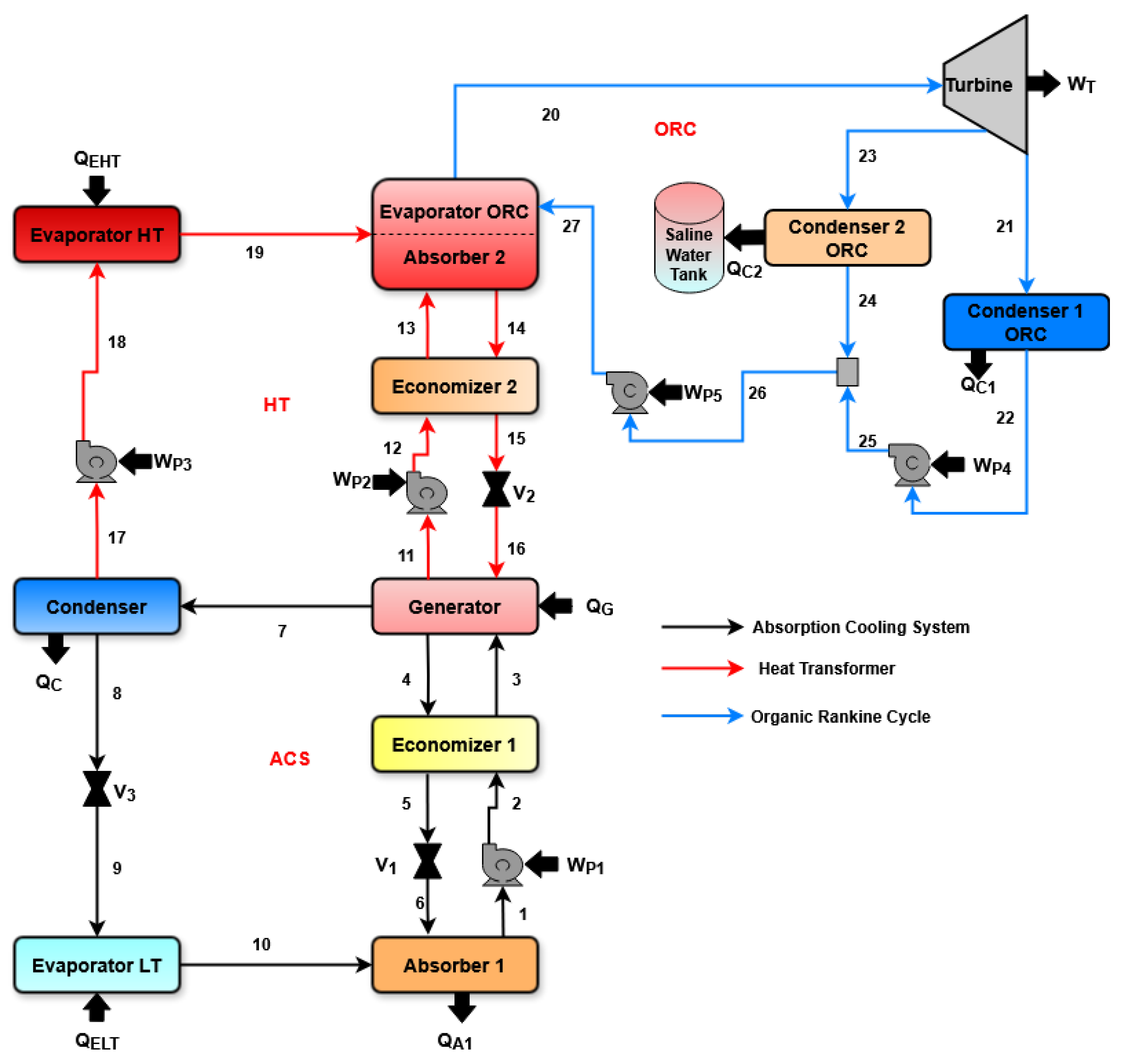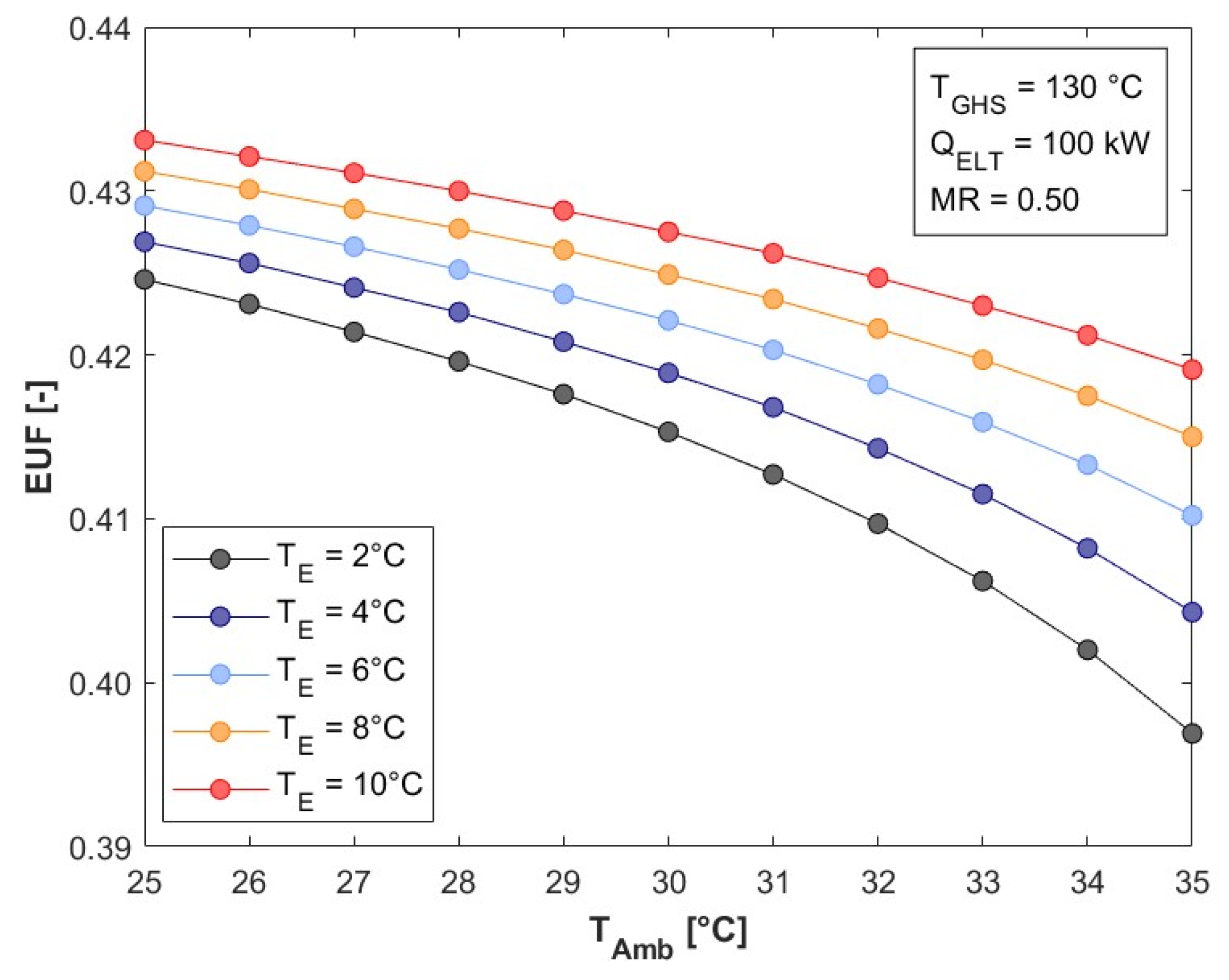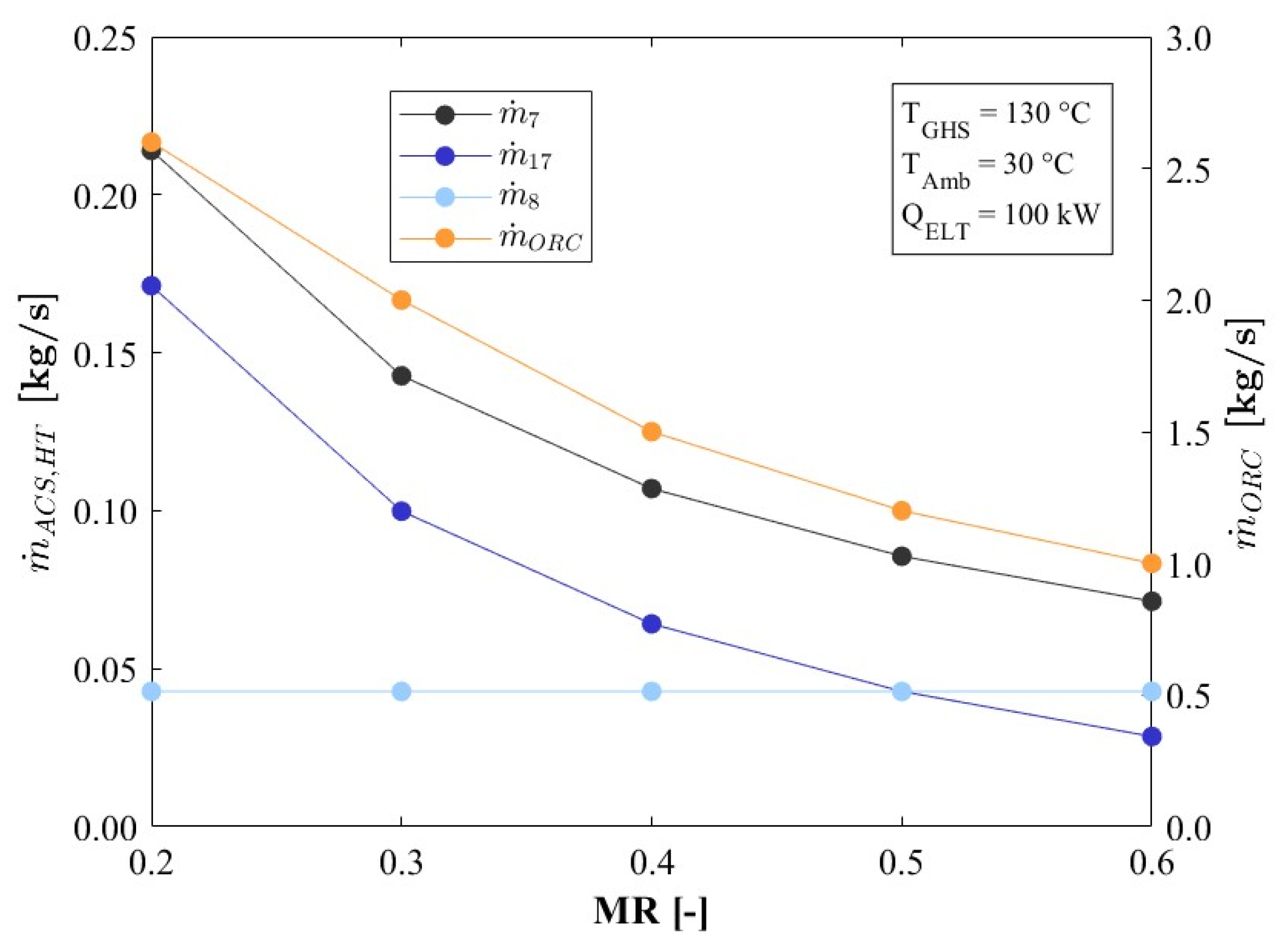A Polygeneration System Based on an Absorption Heat Pump for the Simultaneous Production of Power, Cooling, and Desalinated Water That Operates with Geothermal Energy
Abstract
1. Introduction
1.1. Integration of Gas Turbine Cycles and Heat Recovery in the PgS
1.2. Poligeneration Systems Driven with Renewable Energies
2. System Description
2.1. Description of the Geothermal Field
2.2. Description of the Proposed System
- The selection of the working fluid for the ORC was restricted to fluids classified as isentropic. This ensures that, during expansion in the turbine, the organic fluid at state 21 (see Figure 2) remains in a superheated vapor state, regardless of the expansion ratio. This avoids imposing a constraint on the expansion pressure, which would be necessary when using a wet fluid. Conversely, for dry fluids, a larger expansion results in greater superheating at the turbine exit, which reduces the useful enthalpy available for power generation;
- Critical temperature: only fluids with a critical temperature above the reference heat supply temperature (150 °C) were considered;
- Environmental impact: the selection prioritized fluids with a low environmental impact, specifically those with a low global warming potential (GWP) and ozone depletion potential (ODP);
- Safety: the working fluid, particularly at the highest temperatures in the cycle, had to pose no risk of explosion or flammability;
- Thermal efficiency: the fluid was also required to offer an attractive thermal efficiency.

3. Mathematical Model
System Solution Flowchart
- The system operates under steady-state conditions;
- Heat and pressure losses between component connections are neglected;
- The fluid is considered a saturated vapor at states 10, 19, and 20;
- The fluid is considered a saturated liquid at states 1, 8, 17, 22, and 24;
- The processes in the valves are considered isenthalpic;
- The temperature difference between the condensation process and the environment is 10 °C;
- The temperature difference between the geothermal source and the EHT, as well as between the geothermal source and the generator, is 10 °C.
4. Comparison of the Proposed Model
5. Analysis of Results
5.1. System Analysis Based on Geothermal Source Temperature (TGHS)



5.2. System Analysis Based on Ambient Temperature (TAmb)



5.3. System Analysis Based on Mass Ratio (MR)




6. Conclusions
Author Contributions
Funding
Data Availability Statement
Acknowledgments
Conflicts of Interest
Nomenclature
| Abbreviations | |||
| ACS | Absorption Cooling System | PgS | Polygeneration Systems |
| AHT | Absorption Heat Transformer | RO | Reverse Osmosis |
| CGMD | Conductive Gap Membrane Distillation | Letters and Subscripts | |
| DW | Desalinated Water | A | Absorber |
| Ec | Econimizer | C | Condenser |
| ELT | Evaporator Low Temperature | E | Evaporator |
| EHT | Evaporator High Temperature | G | Generator |
| EUF | Energy Utilization Factor | GHS | Geothermal Heat Source |
| GT | Gas Turbine | P | Pump |
| H-Dh | Humidification-Dehumidification | T | Turbine |
| HT | Heat Transformer | V | Valve |
| MED | Multi-Effect Desalination | Symbol | |
| MED/TVC | Multiple Effect Desalination/Thermal Vapor Compression | Heat [kW] | |
| MR | Mass Ratio | Power [kW] | |
| ORC | Organic Rankine Cycle | Mass flow [kg/s] | |
| PEME | Proton Exchange Membrane Electrolysis | ΔT | Temperature difference |
| PGMD | Permeate Gap Membrane Distillation | ||
References
- Mekonnen, M.M.; Hoekstra, A.Y. Four Billion People Facing Severe Water Scarcity. Sci. Adv. 2016, 2, e1500323. [Google Scholar] [CrossRef] [PubMed]
- Gokcen, G.; Kemal Ozturk, H.; Hepbasli, A. Overview of Kizildere Geothermal Power Plant in Turkey. Energy Convers. Manag. 2004, 45, 83–98. [Google Scholar] [CrossRef]
- Aksoy, N. Power Generation from Geothermal Resources in Turkey. Renew. Energy 2014, 68, 595–601. [Google Scholar] [CrossRef]
- Daǧdaş, A.; Öztürk, R.; Bekdemir, Ş. Thermodynamic Evaluation of Denizli Kızıldere Geothermal Power Plant and Its Performance Improvement. Energy Convers. Manag. 2005, 46, 245–256. [Google Scholar] [CrossRef]
- Lewis, W.; Wallace, K.; Dunford, T.; Harvey, W. Kizildere II Multiple-Flash Combined Cycle: A Novel Approach for a Turkish Resource. In Proceedings of the World Geothermal Congress, Hailey, ID, USA, 19 April 2015. [Google Scholar]
- Anvari, S.; Mahian, O.; Taghavifar, H.; Wongwises, S.; Desideri, U. 4E Analysis of a Modified Multigeneration System Designed for Power, Heating/Cooling, and Water Desalination. Appl. Energy 2020, 270, 115107. [Google Scholar] [CrossRef]
- Hamrang, F.; Shokri, A.; Mahmoudi, S.M.S.; Ehghaghi, B.; Rosen, M.A. Performance Analysis of a New Electricity and Freshwater Production System Based on an Integrated Gasification Combined Cycle and Multi-Effect Desalination. Sustainability 2020, 12, 7996. [Google Scholar] [CrossRef]
- Lei, M.; Alves, J.C.; Alotaibi, M.A.; Chen, J. A Novel Polygeneration Process Integrated into a Gas Turbine Cycle toward an Environmentally Friendly Framework; Application of a Comprehensive 4E Study. Energy 2024, 307, 132728. [Google Scholar] [CrossRef]
- Javadpour, A.; Javaran, E.J.; Lari, K.; Askari, I.B. Techno-Economic Analysis of Combined Gas Turbine, MED and RO Desalination Systems to Produce Electricity and Drinkable Water. Desalination Water Treat. 2019, 159, 232–249. [Google Scholar] [CrossRef]
- Cao, Y.; Delpisheh, M.; Yousefiasl, S.; Athari, H.; El-Shorbagy, M.A.; Jarad, F.; Dahari, M.; Wae-hayee, M. Examination and Optimization of a Novel Auxiliary Trigeneration System for a Ship through Waste-to-Energy from Its Engine. Case Stud. Therm. Eng. 2022, 31, 101860. [Google Scholar] [CrossRef]
- Safder, U.; Rana, M.A.; Yoo, C. Feasibility Study and Performance Assessment of a New Tri-Generation Integrated System for Power, Cooling, and Freshwater Production. Desalination Water Treat. 2020, 183, 63–72. [Google Scholar] [CrossRef]
- Gholizadeh, T.; Vajdi, M.; Rostamzadeh, H. Exergoeconomic Optimization of a New Trigeneration System Driven by Biogas for Power, Cooling, and Freshwater Production. Energy Convers. Manag. 2020, 205, 112417. [Google Scholar] [CrossRef]
- Zhang, M.; Chen, H.; Zoghi, M.; Habibi, H. Comparison between Biogas and Pure Methane as the Fuel of a Polygeneration System Including a Regenerative Gas Turbine Cycle and Partial Cooling Supercritical CO2 Brayton Cycle: 4E Analysis and Tri-Objective Optimization. Energy 2022, 257, 124695. [Google Scholar] [CrossRef]
- Soares, A.P.d.M.R.; de Araújo, H.V.; Dangelo, J.V.H. Thermodynamic Analysis and Optimization of a Biogas-Powered Trigeneration System to Produce Power, Cooling and Freshwater. Fluid. Phase Equilib. 2023, 573, 113872. [Google Scholar] [CrossRef]
- Abou Houran, M.; Ahmad, S.F.; Nutakki, T.U.K.; Agrawal, M.K.; Ghfar, A.A.; Ooi, J.B.; Albani, A.; Xie, S. Numerical Simulation and 4E Analysis of a Steam Methane Reforming-Based Multi Heat Recovery Process, Producing Electricity, Methanol, Fresh Water, Heating, and Coolant. Process Saf. Environ. Prot. 2023, 180, 511–534. [Google Scholar] [CrossRef]
- Ayou, D.S.; Zaragoza, G.; Coronas, A. Small-Scale Renewable Polygeneration System for off-Grid Applications: Desalination, Power Generation and Space Cooling. Appl. Therm. Eng. 2021, 182, 116112. [Google Scholar] [CrossRef]
- Dai, Z.; Yin, X. Investigating the Performance of a Gas Turbine System Combined with Steam Methane Reforming as a Thermochemical Recuperator in a Power, Cooling, Freshwater, and Hydrogen Production Multigeneration System. Energy 2024, 311, 133346. [Google Scholar] [CrossRef]
- Azizi, N.; Esmaeilion, F.; Moosavian, S.F.; Yaghoubirad, M.; Ahmadi, A.; Aliehyaei, M.; Soltani, M. Critical Review of Multigeneration System Powered by Geothermal Energy Resource from the Energy, Exergy, and Economic Point of Views. Energy Sci. Eng. 2022, 10, 4859–4889. [Google Scholar] [CrossRef]
- Khoshgoftar Manesh, M.H.; Onishi, V.C. Energy, Exergy, and Thermo-Economic Analysis of Renewable Energy-Driven Polygeneration Systems for Sustainable Desalination. Processes 2021, 9, 210. [Google Scholar] [CrossRef]
- Kabeel, A.E.; Algazzar, A.M.; Essa, F.A.; Elsheikh, A.H.; Sathyamurthy, R.; Manokar, A.M.; Shanmugan, S.; Panchal, H.; Kumar, R.; Abdelgaied, M. Geothermal and Solar Energy in Water Desalination and Power Generation: Comprehensive Review. Energy Syst. 2024, 1–40. [Google Scholar] [CrossRef]
- Pastor-Martinez, E.; Rubio-Maya, C.; Ambriz-Díaz, V.M.; Belman-Flores, J.M.; Pacheco-Ibarra, J.J. Energetic and Exergetic Performance Comparison of Different Polygeneration Arrangements Utilizing Geothermal Energy in Cascade. Energy Convers. Manag. 2018, 168, 252–269. [Google Scholar] [CrossRef]
- Calise, F.; d’Accadia, M.D.; Macaluso, A.; Piacentino, A.; Vanoli, L. Exergetic and Exergoeconomic Analysis of a Novel Hybrid Solar–Geothermal Polygeneration System Producing Energy and Water. Energy Convers. Manag. 2016, 115, 200–220. [Google Scholar] [CrossRef]
- Calise, F.; Cipollina, A.; Dentice d’Accadia, M.; Piacentino, A. A Novel Renewable Polygeneration System for a Small Mediterranean Volcanic Island for the Combined Production of Energy and Water: Dynamic Simulation and Economic Assessment. Appl. Energy 2014, 135, 675–693. [Google Scholar] [CrossRef]
- Angrisani, G.; Diglio, G.; Sasso, M.; Calise, F.; Dentice d’Accadia, M. Design of a Novel Geothermal Heating and Cooling System: Energy and Economic Analysis. Energy Convers. Manag. 2016, 108, 144–159. [Google Scholar] [CrossRef]
- Calise, F.; Dentice d’Accadia, M.; Macaluso, A.; Vanoli, L.; Piacentino, A. A Novel Solar-Geothermal Trigeneration System Integrating Water Desalination: Design, Dynamic Simulation and Economic Assessment. Energy 2016, 115, 1533–1547. [Google Scholar] [CrossRef]
- Musharavati, F.; Khanmohammadi, S.; Pakseresht, A. Proposed a New Geothermal Based Poly-Generation Energy System Including Kalina Cycle, Reverse Osmosis Desalination, Elecrolyzer Amplified with Thermoelectric: 3E Analysis and Optimization. Appl. Therm. Eng. 2021, 187, 116596. [Google Scholar] [CrossRef]
- Ghiasirad, H.; Asgari, N.; Khoshbakhti Saray, R.; Mirmasoumi, S. Thermoeconomic Assessment of a Geothermal Based Combined Cooling, Heating, and Power System, Integrated with a Humidification-Dehumidification Desalination Unit and an Absorption Heat Transformer. Energy Convers. Manag. 2021, 235, 113969. [Google Scholar] [CrossRef]
- Shi, P.; Shang, R. Performance Evaluation and Optimization of a Multigeneration Hybrid System for Power, Hydrogen, Cooling, and Freshwater Production from Renewable Sources. Appl. Therm. Eng. 2024, 246, 122866. [Google Scholar] [CrossRef]
- Ghaebi, H.; Shekari Namin, A.; Rostamzadeh, H. Performance Assessment and Optimization of a Novel Multi-Generation System from Thermodynamic and Thermoeconomic Viewpoints. Energy Convers. Manag. 2018, 165, 419–439. [Google Scholar] [CrossRef]
- Yao, Z.; Yuxing, Z.; Yaqian, K.; Sobhani, B. Research on an Integrated Power and Freshwater Generation System from Natural Gas Energy and Geothermal Sources. Desalination 2022, 525, 115494. [Google Scholar] [CrossRef]
- Mehrpooya, M.; Ghorbani, B.; Hosseini, S.S. Thermodynamic and Economic Evaluation of a Novel Concentrated Solar Power System Integrated with Absorption Refrigeration and Desalination Cycles. Energy Convers. Manag. 2018, 175, 337–356. [Google Scholar] [CrossRef]
- Mata-Torres, C.; Zurita, A.; Cardemil, J.M.; Escobar, R.A. Exergy Cost and Thermoeconomic Analysis of a Rankine Cycle + Multi-Effect Distillation Plant Considering Time-Varying Conditions. Energy Convers. Manag. 2019, 192, 114–132. [Google Scholar] [CrossRef]
- Hai, T.; Chaturvedi, R.; Almujibah, H.; Marjan, R.K.; Van Thuong, T.; Soliman, N.; El-Shafai, W.; Fouad, H. Integrating Geothermal Energy and Desalination Unit into a Poly-Generation Configuration: Comprehensive Study and Optimization. Desalination 2024, 586, 117873. [Google Scholar] [CrossRef]
- Shamsi, M.; Karami, B.; Cheraghdar, A.; Mousavian, S.; Makki, M.; Rooeentan, S. Evaluation of an Environmentally-Friendly Poly-Generation System Driven by Geothermal Energy for Green Ammonia Production. Fuel 2024, 365, 131037. [Google Scholar] [CrossRef]
- Aguilar-Jiménez, J.A.; Velázquez, N.; López-Zavala, R.; Beltrán, R.; Hernández-Callejo, L.; González-Uribe, L.A.; Alonso-Gómez, V. Low-Temperature Multiple-Effect Desalination/Organic Rankine Cycle System with a Novel Integration for Fresh Water and Electrical Energy Production. Desalination 2020, 477, 114269. [Google Scholar] [CrossRef]
- Ortega-Delgado, B.; Palenzuela, P.; Alarcón-Padilla, D.-C. Parametric Study of a Multi-Effect Distillation Plant with Thermal Vapor Compression for Its Integration into a Rankine Cycle Power Block. Desalination 2016, 394, 18–29. [Google Scholar] [CrossRef]
- Cataldi, R.; Mongelli, F.; Squarci, P.; Taffi, L.; Zito, G.; Calore, C. Geothermal Ranking of Italian Territory. Geothermics 1995, 24, 115–129. [Google Scholar] [CrossRef]
- Bibby, H.M.; Caldwell, T.G.; Davey, F.J.; Webb, T.H. Geophysical Evidence on the Structure of the Taupo Volcanic Zone and Its Hydrothermal Circulation. J. Volcanol. Geotherm. Res. 1995, 68, 29–58. [Google Scholar] [CrossRef]
- Thomas, D.M. Geothermal Resources Assessment in Hawaii. Geothermics 1986, 15, 435–514. [Google Scholar] [CrossRef]
- Gutiérrez-Negrín, L.C.; Canchola Félix, I.; Romo-Jones, J.M.; Quijano-León, J.L. Geothermal Energy in Mexico: Update and Perspectives. In Proceedings of the World Geothermal Congress, Reykjavik, Iceland, 26 April–2 May 2020; pp. 1–13. [Google Scholar]
- DiPippo, R. Geothermal Power Plants: Principles, Applications, Case Studies and Environmental Impact, 3rd ed.; Butterworth-Heinemann: Dartmouth, MA, USA, 2012. [Google Scholar]
- Castillo, H.D.; De la Cruz, M.V. Reconocimiento Estructural y Volcanológico En Ia Zona Termal Del Domo San Pedro Lagunillas, Nayarit, Mexico. Geofísica Int. 1992, 31, 407–415. [Google Scholar] [CrossRef]
- Rodríguez, E.; Ocampo, F.; Reyes, V.; Ávalos, D.; García, J. Preliminary Geochemical Model of the Domo San Pedro Geothermal Field in San Pedro Lagunillas, Mexico. In Proceedings of the 44th Workshop on Geothermal Reservoir Engineering, Stanford, CA, USA, 11–13 February 2019. [Google Scholar]
- Gómez Cruz, A. Caracterización Mineralógica y Geotermométrica de Muestras de Pozo Del Domo San Pedro, Nayarit México. Master’s Thesis, Universidad Nacional Autónoma de México, Ciudad de México, Mexico, 2018. [Google Scholar]
- Bahrami, M.; Pourfayaz, F.; Kasaeian, A. Low Global Warming Potential (GWP) Working Fluids (WFs) for Organic Rankine Cycle (ORC) Applications. Energy Rep. 2022, 8, 2976–2988. [Google Scholar] [CrossRef]
- Zhang, X.; Zhang, C.; He, M.; Wang, J. Selection and Evaluation of Dry and Isentropic Organic Working Fluids Used in Organic Rankine Cycle Based on the Turning Point on Their Saturated Vapor Curves. J. Therm. Sci. 2019, 28, 643–658. [Google Scholar] [CrossRef]
- Elahi, A.E.; Mahmud, T.; Alam, M.; Hossain, J.; Biswas, B.N. Exergy Analysis of Organic Rankine Cycle for Waste Heat Recovery Using Low GWP Refrigerants. Int. J. Thermofluids 2022, 16, 100243. [Google Scholar] [CrossRef]
- Yaïci, W.; Entchev, E.; Longo, M. Organic Rankine Cycle-Ejector Heat Pump Hybrid System Using Low GWP Zeotropic Mixtures for Trigeneration Application. Energy Convers. Manag. 2024, 299, 117853. [Google Scholar] [CrossRef]
- Verma, A.; Kaushik, S.C.; Tyagi, S.K. Performance Enhancement of Absorption Refrigeration Systems: An Overview. J. Therm. Eng. 2023, 9, 1100–1113. [Google Scholar] [CrossRef]
- Delgado-Gonzaga, J.; Rivera, W.; Juárez-Romero, D. Integration of Cycles by Absorption for the Production of Desalinated Water and Cooling. Appl. Therm. Eng. 2023, 220, 119718. [Google Scholar] [CrossRef]
- Gude, V.G.; Nirmalakhandan, N. Combined Desalination and Solar-Assisted Air-Conditioning System. Energy Convers. Manag. 2008, 49, 3326–3330. [Google Scholar] [CrossRef]


| Generator (G) | Evaporator High Temperature (EHT) |
| Condenser (C) | Evaporator ORC (EORC) |
| Evaporator Low Temperature (ELT) | Turbine (T) |
| Absorber 1 (A1) | Condenser 1 (C1) |
| Economizer 1 (Ec1) | Condenser 2 (C2) |
| Economizer 2 (Ec2) | Pumps (P) − ) |
| Absorber 2 (A2) | Valves (V) |
| Parameter | Delgado et al. [50] | Present Work | Difference [%] |
|---|---|---|---|
| TG [°C] | 82 | 82 | 0 |
| TEHT [°C] | 82 | 82 | 0 |
| TC [°C] | 32 | 32 | 0 |
| TA [°C] | 32 | 32 | 0 |
| TE [°C] | 7 | 7 | 0 |
| [kW] | 100 | 100 | 0 |
| DW [kg/h] | 136 | 150.2 | 15.54 |
| [kW] | - | 5.65 | - |
Disclaimer/Publisher’s Note: The statements, opinions and data contained in all publications are solely those of the individual author(s) and contributor(s) and not of MDPI and/or the editor(s). MDPI and/or the editor(s) disclaim responsibility for any injury to people or property resulting from any ideas, methods, instructions or products referred to in the content. |
© 2025 by the authors. Licensee MDPI, Basel, Switzerland. This article is an open access article distributed under the terms and conditions of the Creative Commons Attribution (CC BY) license (https://creativecommons.org/licenses/by/4.0/).
Share and Cite
Pacheco-Reyes, A.; Jiménez-García, J.C.; Gutiérrez-Urueta, G.L.; Saucedo-Velázquez, J.; Rivera, W. A Polygeneration System Based on an Absorption Heat Pump for the Simultaneous Production of Power, Cooling, and Desalinated Water That Operates with Geothermal Energy. Processes 2025, 13, 2016. https://doi.org/10.3390/pr13072016
Pacheco-Reyes A, Jiménez-García JC, Gutiérrez-Urueta GL, Saucedo-Velázquez J, Rivera W. A Polygeneration System Based on an Absorption Heat Pump for the Simultaneous Production of Power, Cooling, and Desalinated Water That Operates with Geothermal Energy. Processes. 2025; 13(7):2016. https://doi.org/10.3390/pr13072016
Chicago/Turabian StylePacheco-Reyes, A., J. C. Jiménez-García, G. L. Gutiérrez-Urueta, J. Saucedo-Velázquez, and W. Rivera. 2025. "A Polygeneration System Based on an Absorption Heat Pump for the Simultaneous Production of Power, Cooling, and Desalinated Water That Operates with Geothermal Energy" Processes 13, no. 7: 2016. https://doi.org/10.3390/pr13072016
APA StylePacheco-Reyes, A., Jiménez-García, J. C., Gutiérrez-Urueta, G. L., Saucedo-Velázquez, J., & Rivera, W. (2025). A Polygeneration System Based on an Absorption Heat Pump for the Simultaneous Production of Power, Cooling, and Desalinated Water That Operates with Geothermal Energy. Processes, 13(7), 2016. https://doi.org/10.3390/pr13072016







